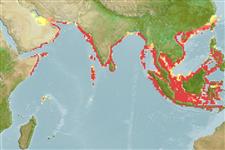Classification / Names
Common names from other countries
Main reference
Size / Weight / Age
Max length : 30.0 cm SL male/unsexed; (Ref. 9772); common length : 20.0 cm SL male/unsexed; (Ref. 9772)
Length at first maturity
Lm ?, range 14 - ? cm
Environment
Marine; demersal; depth range ? - 60 m (Ref. 9772)
Climate / Range
Tropical, preferred 28°C (Ref. 107945); 29°N - 10°S, 48°E - 125°E
Distribution
Short description
Dorsal
spines
(total): 10 - 11;
Dorsal
soft rays
(total): 224;
Anal
spines: 2;
Anal
soft rays: 7. Mental pores in 2 pairs, both small, the first pair at front of chin, separated by symphysis. Gill rakers slender, as long as gill filaments at angle of arch, 9-12 on lower limb. Dorsal fin with 22-24 soft rays. Second anal spine short, slender, 22-36 % of head length. Caudal fin truncate. Scales cycloid (smooth) on head and flanks. Swim bladder carrot-shaped, with 17-22 pairs of fan-like appendages along its sides, the first not entering head. Sagitta (large earstone) with a tadpole-shaped impression, the tail of which is hockey-stick-shaped. Nape with a diffused dusky blotch.
IUCN Red List Status (Ref. 115185)
Threat to humans
Harmless
Human uses
Fisheries: commercial
More information
ReferencesAquacultureAquaculture profileStrainsGeneticsAllele frequenciesHeritabilityDiseasesProcessingMass conversion
Tools
Special reports
Download XML
Internet sources
Estimates of some properties based on models
Phylogenetic diversity index
PD50 = 0.5312 many relatives (e.g. carps) 0.5 - 2.0 few relatives (e.g. lungfishes)
Trophic Level
4.0 ±0.69 se; Based on food items.
Resilience
High, minimum population doubling time less than 15 months (K=0.53-1.94)
Vulnerability
Low to moderate vulnerability (26 of 100)
Price category
